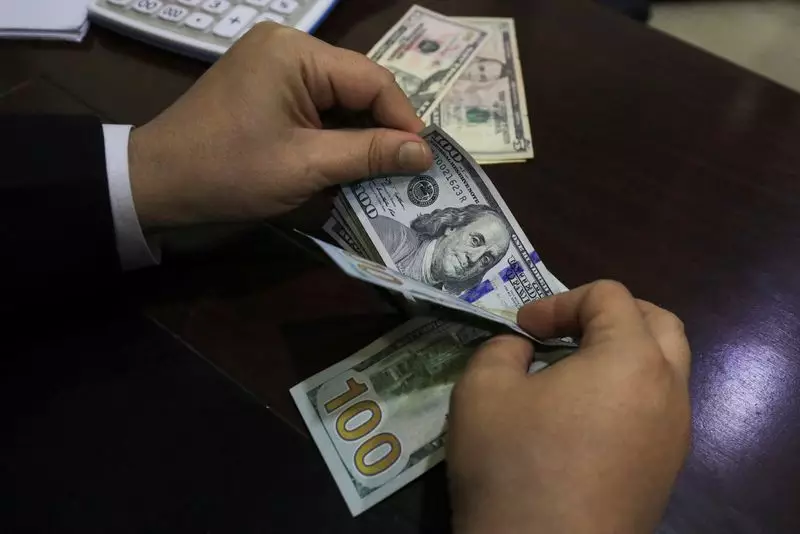In the world of finance, the subtle nuances of economic policy can make or break currency values, and recent developments surrounding President-elect Donald Trump’s trade policies have certainly introduced a layer of complexity to market dynamics. As traders scrutinize the potential impact of the tariffs mooted by Trump, the U.S. dollar finds itself oscillating near a one-week low against major currencies, including the euro and the British pound. This fluctuation poses critical questions about the future trajectory of the American economy and its global standing.
On a particularly turbulent trading day, the U.S. dollar slipped in value following an article from the Washington Post. This report suggested that Trump’s administration might apply tariffs selectively, targeting only those sectors deemed critical for national security and economic welfare. The dollar reacted swiftly, as traders reassessed their positions in light of this news, leading to a drop to 107.74—its lowest point since the end of December. Such a sharp decline illustrates how sensitive the markets are to tariff discussions, especially considering that the previously anticipated sweeping tariff measures expected from Trump seem less likely to materialize.
The U.S. dollar index, which benchmarks the greenback against a basket of currencies, did experience a mild recovery up to 108.38. This stabilization can be attributed to Trump’s swift denial of the Washington Post’s claims via his social media platform, Truth Social. However, the situation remains precarious, as the market interpretation of these tariffs exhibits a reluctance to fully embrace the previous bullish expectations that had driven the dollar higher earlier in the month.
Chris Weston, head of research at Pepperstone, provides insight into the broader implications of these tariff discussions. He notes that many market participants had already considered Trump’s initially proposed universal tariffs of 10-20% as unlikely to be enacted in an uncompromising manner. The recent revelations have reinforced this skepticism, hinting that a nuanced approach could be on the horizon, which might ultimately benefit economic negotiations rather than hinder them.
Moreover, the traders’ sentiment remains tied to the evolving narrative around Trump’s economic policies. The anticipation of fiscal stimulus and deregulatory measures initially buoyed the dollar, setting a high watermark of 109.58 earlier this month. However, the shift in expectation—coupled with political dynamics—could drastically alter projections for U.S. growth in the near term.
As the U.S. dollar wrestled with volatility, other currencies were not insulated from the ripple effects of these developments. The euro, often a target in Trump’s tariff rhetoric, saw slight depreciation to around $1.03795, retreating from a one-week peak earlier in the trading session. Similarly, sterling encountered headwinds, falling to $1.125085 after a stronger performance the previous day. Observing these shifts highlights the interconnected nature of global currencies, emphasizing how local policy changes can resonate widely across financial landscapes.
Additionally, the U.S. dollar’s rise to 158.23 yen illustrates the influence of domestic factors, including climbing Treasury yields, which can have a significant effect on foreign exchange rates. Market analysts like Kyle Rodda of Capital.com suggest that the evolving political landscape in Canada, with Prime Minister Justin Trudeau set to resign, has also influenced traders’ sentiment, contributing to fluctuations in the Canadian dollar’s value.
Interestingly, amidst the chaos in traditional markets, cryptocurrency has emerged as a notable player. Bitcoin surged approximately 0.9%, surpassing $102,560 and reaching heights not seen since mid-December. This recovery in the crypto market suggests a growing investor appetite for alternatives to conventional currencies amidst economic uncertainty.
As we assess the implications of President-elect Trump’s trade policies, it is clear that the road ahead for the U.S. dollar—and the broader economy—remains fraught with uncertainty. The evolving landscape requires investors to stay agile and informed, navigating the interplay of domestic policy, international relations, and broader economic indicators. The ultimate question arises: how will the anticipatory landscape shape the value of the dollar in the months ahead, particularly as more clarity emerges around Trump’s administration and its proposed economic strategies? The markets are watching closely, ready to react to every nuance.

